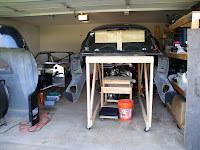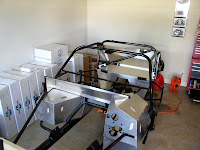This week we actually started working through the Assembly Manual itself. Until now all we've done is preparatory work, so it was nice to attach some things to the car.
We started by removing all of the aluminum pieces that came on the car. We took lots of pictures so we can figure out how to put them back in later.
The first steps in assembly were to bend brake lines around some of the frame from the rear axle all the way to the front wheels. It took a few tries to get it right, but we eventually made pieces that fit and got them riveted in place on the chassis. We also ran some fuel lines under the passenger side of the car. Those really tall lines sticking up in the engine bay are in preparation for running fuel lines to the engine later.
We also received the valve covers we ordered, so we put those on. They look nice without being too shiny.


Speaking of shiny, as we conducted a full inventory last week of every nut and bolt we did take pictures of a few parts. Here are the guages for the dash, our seatbelts (a real racing harness!), and the fuel filler cap. The filler cap has a spring-loaded opening mechanism that was invented by endurance racers to speed up fuel stops. Ours has a real fuel cap hidden underneath, but the chrome cap replicates the original look.



This evening, we installed much of the front suspension. It was too dark for pictures, so you'll have to wait until next week!

















